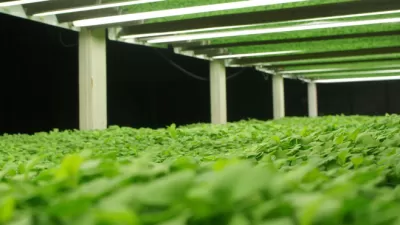Chicagoans sure take their urban agriculture seriously. While the city focuses on converting vacant land to farms in some of the city's struggling neighborhoods, entrepreneurs are doing the same indoors.

Utilizing a soil-free, aquaponic process, FarmedHere has just opened the largest indoor vertical farm in the United States in "a formerly abandoned suburban Chicago warehouse."
"The facility hopes to produce an anticipated 1 million pounds of chemical-, herbicide- and pesticide-free leafy greens -- including basil, arugula, mints and other greens -- to the Chicago area once it hits full production," says an article in the Huffington Post. "In addition, the facility says by 2014 it will be providing about 200 jobs to the community, many of them via a partnership with Windy City Harvest, a Chicago Botanic Garden-led urban agriculture training program targeted to underserved local youths."
"The Bedford Park facility is FarmedHere's third farm, joining a 10,000-square-foot facility in downstate Flanagan and a 4,000-square-foot one in Englewood. Whole Foods, which sells the company's greens in its Chicago stores, helped finance the new facility with a $100,000 loan, Crain's previously reported."
FULL STORY: FarmedHere, Nation's Largest Indoor Vertical Farm, Opens In Chicago Area

Trump Administration Could Effectively End Housing Voucher Program
Federal officials are eyeing major cuts to the Section 8 program that helps millions of low-income households pay rent.

Planetizen Federal Action Tracker
A weekly monitor of how Trump’s orders and actions are impacting planners and planning in America.

Ken Jennings Launches Transit Web Series
The Jeopardy champ wants you to ride public transit.

California Invests Additional $5M in Electric School Buses
The state wants to electrify all of its school bus fleets by 2035.

Austin Launches $2M Homelessness Prevention Fund
A new grant program from the city’s Homeless Strategy Office will fund rental assistance and supportive services.

Alabama School Forestry Initiative Brings Trees to Schoolyards
Trees can improve physical and mental health for students and commnity members.
Urban Design for Planners 1: Software Tools
This six-course series explores essential urban design concepts using open source software and equips planners with the tools they need to participate fully in the urban design process.
Planning for Universal Design
Learn the tools for implementing Universal Design in planning regulations.
Ada County Highway District
Clanton & Associates, Inc.
Jessamine County Fiscal Court
Institute for Housing and Urban Development Studies (IHS)
City of Grandview
Harvard GSD Executive Education
Toledo-Lucas County Plan Commissions
Salt Lake City
NYU Wagner Graduate School of Public Service




























